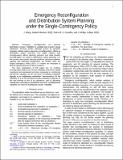Emergency reconfiguration and distribution system planning under the Single-Contingency Policy
Author(s)
Wang, J.; Carvalho, Pedro M. S.; Kirtley, James L., Jr.
DownloadISGT2012_2.pdf (285.9Kb)
OPEN_ACCESS_POLICY
Open Access Policy
Creative Commons Attribution-Noncommercial-Share Alike
Terms of use
Metadata
Show full item recordAbstract
Emergency reconfiguration can improve distribution systems' reliability by enabling load transfer among substations. Previous studies, although present its operation strategies, seldom explore emergency reconfiguration's effects on distribution system planning. This paper explores how reconfiguration affects planning decisions and what benefits reconfiguration can bring to distribution system planning. For this purpose, two specific planning problems, planning substation capacity and allocating transformers, are studied under the Single-Contingency Policy (SCP). LP models are developed to find the optimal decisions in above problems. The main implications of this paper are: (1) enabling reconfigurable feeders can increase reliability with lower capital investment and operational cost when comparing to reinforcing transformer capacity; (2) the max-load of individual substation depends on its neighboring substations' characteristics; (3) the reliability of a set of well interconnected substations depends on the max-shortage of one of its substations; and (4) allocating transformers according to distribution networks' reconfiguration capability can improve distribution systems' reliability.
Date issued
2012-01Department
Massachusetts Institute of Technology. Department of Electrical Engineering and Computer ScienceJournal
2012 IEEE PES Innovative Smart Grid Technologies (ISGT)
Publisher
Institute of Electrical and Electronics Engineers
Citation
Wang, J., Pedro M. S. Carvalho, and J. Kirtley. Emergency Reconfiguration and Distribution System Planning Under the Single-Contingency Policy. In 2012 IEEE PES Innovative Smart Grid Technologies (ISGT), 1-5. Institute of Electrical and Electronics Engineers, 2012.
Version: Author's final manuscript
Other identifiers
INSPEC Accession Number: 12639973
ISBN
978-1-4577-2159-5
978-1-4577-2158-8
978-1-4577-2157-1